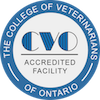Having your ferret spayed (female) or neutered (male) make for happier, healthier pets and it makes your life better too! Hormonal activity is the strongest contributor to ferret odor. Ferrets have tiny musk glands scattered throughout their skin, with heavier concentrations in the face and legs. When ferrets (both male and female) are unaltered, hormones cause these musk glands to produce lots of smelly oil. Fixing your ferret will reduce musk production by about 90 percent, because the skin glands shrink. It is one of the most important things you can do to reduce ferret odor as well as help reduce serious health and behavioral problems for your ferret. Our veterinarians are trained to perform this procedure, call to schedule your appointment today.
Surgical Services
Having your rabbit neutered (male) or spayed (female) does wonders for their health and happiness, and both male and female rabbits should have it done. It is important for many reasons including decreasing aggression and inappropriate elimination (urine spraying) and prevents pregnancy. Choosing the right veterinarian to perform these procedures is important and our team is well equipped and trained to provide exceptional care. Please contact our team today for more information or to schedule an appointment.
 Imagine what your mouth would feel like if you never brushed your teeth or went to the dentist. For many dogs and cats, this is a painful reality. According to the American Veterinary Dental Society, more than 80% of dogs and 70% of cats have dental disease by the age of 3. Dental (or periodontal) disease is the most frequently diagnosed health problem in pets.
Imagine what your mouth would feel like if you never brushed your teeth or went to the dentist. For many dogs and cats, this is a painful reality. According to the American Veterinary Dental Society, more than 80% of dogs and 70% of cats have dental disease by the age of 3. Dental (or periodontal) disease is the most frequently diagnosed health problem in pets.
Common signs of dental disease include:
- Yellow or brown buildup (tartar) on the teeth
- Red, swollen, or bleeding gums
- Bad breath
- Excessive drooling
- Changes in eating or chewing habits
- Pawing at the face
- Loose teeth
- Depression
Even if your dog or cat doesn’t have these symptoms, we recommend that you have a veterinarian evaluate your pet’s dental health at least once a year. Bacteria and food debris accumulate around the teeth and, if left unchecked, will lead to deterioration of the soft tissue and bone surrounding the teeth. This decay can result in irreversible periodontal disease, tooth loss, and possibly expensive oral surgery.
Dental disease can also affect other organs in the body: Bacteria in the mouth can get into the bloodstream and cause serious infections in the kidneys, liver, lungs, and heart. If these problems aren’t caught and treated quickly enough, they can result in death. A physical exam combined with appropriate laboratory work can determine if infection in the mouth has spread.
Dental Radiograph:
X-rays of your pet’s teeth are vital to evaluate your pet’s oral health. X-rays also detect abnormalities that cannot be seen through an oral examination alone. They also confirm the need for tooth extraction when teeth are loose or badly infected. When a dental scaling and polishing has been performed on your pet, or if teeth have been extracted be sure to always ask to see the dental radiographs.
COHAT- What you can expect with a full COHAT procedure
Schedule your pet’s Complimentary Dental Exam today!
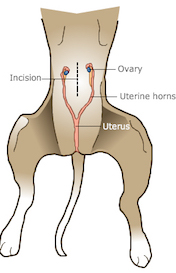 Spaying your pet has many benefits. The procedure, which prevents female animals from becoming pregnant and reproducing, can help your dog or cat live a longer, healthier life. Spaying will not change your pet’s personality.
Spaying your pet has many benefits. The procedure, which prevents female animals from becoming pregnant and reproducing, can help your dog or cat live a longer, healthier life. Spaying will not change your pet’s personality.
By spaying your female pet, you’re protecting her against potentially deadly diseases, including bacterial infections, reproductive tract diseases, and several types of cancer. You also won’t have to worry about her going into heat. This means avoiding the mess that often accompanies the heat cycle in female dogs and the pacing and crying that happens with female cats. In addition, spaying your pet will help control the dog and cat overpopulation problem, keeping more animals out of shelters.
Spaying, which involves removing the ovaries and uterus, is a surgical procedure and does need to be performed with the pet under anesthesia. We follow strict protocols and continually monitor your pet’s vital signs to help ensure her safety. Please see the descriptions under Anesthesia and Patient Monitoring for more information on what we do to keep your pet safe.
To set up an appointment to have your pet spayed or to learn more about this procedure, call or visit our clinic. If you are struggling with the decision of whether to spay your pet, please call us so we can discuss your concerns.
Book an Appointment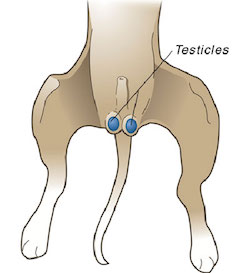 Neutering your pet has many benefits. The procedure, which prevents male animals from reproducing, can help your dog or cat live a longer, healthier life. Neutering will not change your pet’s personality.
Neutering your pet has many benefits. The procedure, which prevents male animals from reproducing, can help your dog or cat live a longer, healthier life. Neutering will not change your pet’s personality.
By neutering your pet, you’re reducing or eliminating his risk for prostate and testicular cancer, as well as sexually transmitted diseases. Neutering will also reduce or eliminate undesirable and embarrassing behavior, including roaming, fighting, humping, and spraying. In addition, neutering your pet will help control the dog and cat overpopulation problem, keeping more animals out of shelters.
Neutering, which involves removing the testicles, is a surgical procedure and does need to be performed with the pet under anesthesia. We follow strict protocols and continually monitor your pet’s vital signs to help ensure his safety. Please see the descriptions under Anesthesia and Patient Monitoring for more information on what we do to keep your pet safe.
To set up an appointment to have your pet neutered or to learn more about this procedure, please call or visit our clinic. If you are struggling with the decision of whether to neuter your pet, please call us or stop by so we can discuss your concerns.
Book an Appointment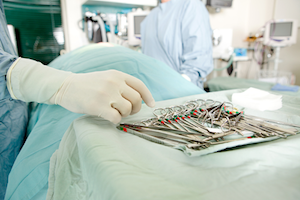 We perform many types of soft tissue surgeries at our clinic. Soft tissue surgeries are those that are not associated with bone. These surgeries can provide many benefits to pets.
We perform many types of soft tissue surgeries at our clinic. Soft tissue surgeries are those that are not associated with bone. These surgeries can provide many benefits to pets.
Probably the most common soft tissue surgery performed on pets is the removal of masses, or lumps. Most of these masses, once removed and tested, are found to be benign (nonharmful); however, occasionally they are more serious. Early removal and accurate diagnosis of a lump is necessary to improve the outcome in your pet if the mass is cancerous.
If your dog suffers from frequent ear infections, surgical intervention can reduce their occurrence by improving airflow into the ear canal.
Surgery can also help resolve several problems related to the eyes. Tearing in your pet’s eyes can mean an infection is present or may be a sign that the cornea (outer layer of the eye) has been damaged. Surgery may allow the cornea to heal faster with less scarring, improving your pet’s ability to see. In some pets, the eyelashes may actually damage the cornea. Surgical intervention improves comfort in these pets, reduces the chances of corneal scarring, and enhances the pet’s vision in the long term.
Please contact us if you’d like to discuss how soft tissue surgery might be able to help your pet.
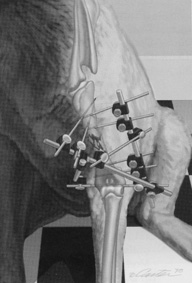 We perform many types of orthopedic (bone) surgeries in our clinic. Because we want to ensure that our patients receive the best possible outcome, we occasionally refer them to board-certified orthopedic surgeons to perform back surgery and other very complex surgeries.
We perform many types of orthopedic (bone) surgeries in our clinic. Because we want to ensure that our patients receive the best possible outcome, we occasionally refer them to board-certified orthopedic surgeons to perform back surgery and other very complex surgeries.
Leg fractures are the most common orthopedic problem presented at our clinic and usually result from a mishap with an automobile. They can be treated in a variety of ways depending on the location and type of fracture. We can apply a cast to treat certain fractures; however, many fractures will require surgical intervention:
- “Pinning” stabilizes the fracture by inserting a long stainless steel rod into the middle of the bone across the fractured area.
- “Plating” involves attaching a flat stainless steel plate to the bone using screws on either side of the fracture.
- “External fixation” stabilizes fractures using a series of pins on the outside of the leg that pass through the skin and into the bone on either side of the fracture.
Cruciate Repair
The most common injury of the knee is a rupture of the cranial cruciate ligament. When the CCL is torn, instability occurs that allows the bones to move in an abnormal fashion in relation to one another, causing damage to the joint cartilage.
In younger dogs, rupture of the CCL is usually the result of trauma to the stifle joint. In some cases, the ligament may only partially tear; however, this will eventually lead to complete tearing of the ligament. When CCL rupture occurs in older dogs, it is most frequently initiated by a progressive degenerative change in the ligament with eventual total rupture. A dog can simply be running in the back yard, plant the foot for a turn, and the ligament breaks.
A dog’s weight can be a strong contributing factor in a cruciate rupture. The ligament may become weakened due to carrying too much weight; this causes it to tear easily. Obesity will make the recovery time much longer, and it will make the other knee very susceptible to cruciate rupture.
Dogs with a ruptured CCL are usually lame and may refuse to bear weight on the affected leg. As the acute pain subsides, most dogs become more willing to bear weight, but some degree of lameness remains.
Small dogs may get enough stability in the joint to avoid surgery, but in most cases, correction of CCL rupture is going to require a surgical repair.
We also perform a lot of orthopedic surgeries related to hip dysplasia and disc disease. Please contact us if you have any questions about these procedures or if you think your pet might benefit from them.
Cryosurgery is a relatively painless surgical procedure that uses extremely cold temperatures to remove or destroy small growths on the skin. This same procedure is used on people.
If your pet has growths you are concerned about or would like to have removed, please contact us to set up an appointment.


